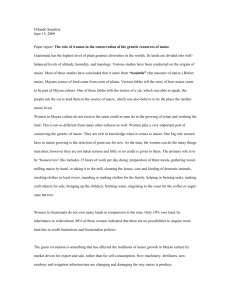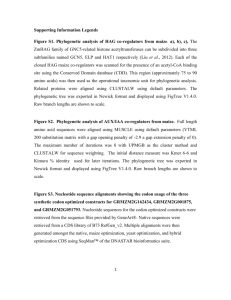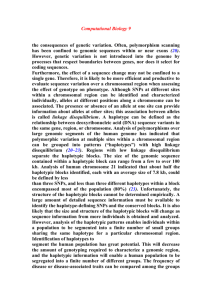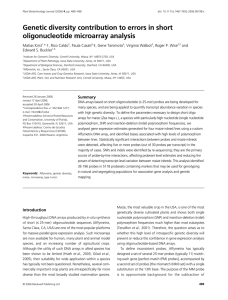Supplemental Material
advertisement
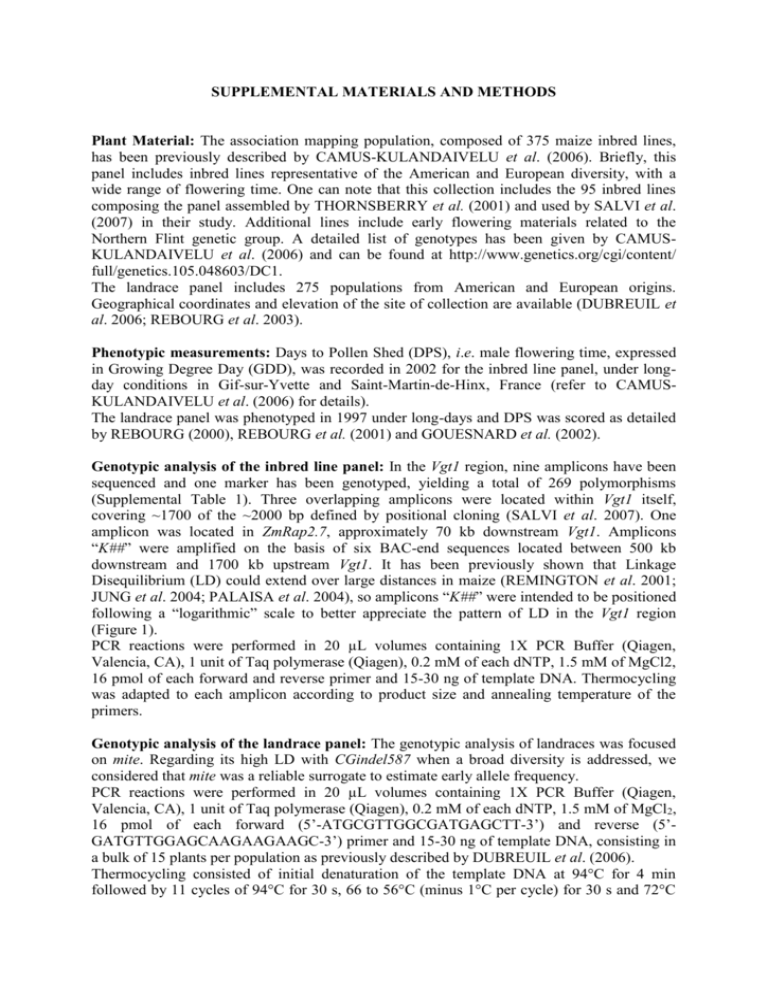
SUPPLEMENTAL MATERIALS AND METHODS Plant Material: The association mapping population, composed of 375 maize inbred lines, has been previously described by CAMUS-KULANDAIVELU et al. (2006). Briefly, this panel includes inbred lines representative of the American and European diversity, with a wide range of flowering time. One can note that this collection includes the 95 inbred lines composing the panel assembled by THORNSBERRY et al. (2001) and used by SALVI et al. (2007) in their study. Additional lines include early flowering materials related to the Northern Flint genetic group. A detailed list of genotypes has been given by CAMUSKULANDAIVELU et al. (2006) and can be found at http://www.genetics.org/cgi/content/ full/genetics.105.048603/DC1. The landrace panel includes 275 populations from American and European origins. Geographical coordinates and elevation of the site of collection are available (DUBREUIL et al. 2006; REBOURG et al. 2003). Phenotypic measurements: Days to Pollen Shed (DPS), i.e. male flowering time, expressed in Growing Degree Day (GDD), was recorded in 2002 for the inbred line panel, under longday conditions in Gif-sur-Yvette and Saint-Martin-de-Hinx, France (refer to CAMUSKULANDAIVELU et al. (2006) for details). The landrace panel was phenotyped in 1997 under long-days and DPS was scored as detailed by REBOURG (2000), REBOURG et al. (2001) and GOUESNARD et al. (2002). Genotypic analysis of the inbred line panel: In the Vgt1 region, nine amplicons have been sequenced and one marker has been genotyped, yielding a total of 269 polymorphisms (Supplemental Table 1). Three overlapping amplicons were located within Vgt1 itself, covering ~1700 of the ~2000 bp defined by positional cloning (SALVI et al. 2007). One amplicon was located in ZmRap2.7, approximately 70 kb downstream Vgt1. Amplicons “K##” were amplified on the basis of six BAC-end sequences located between 500 kb downstream and 1700 kb upstream Vgt1. It has been previously shown that Linkage Disequilibrium (LD) could extend over large distances in maize (REMINGTON et al. 2001; JUNG et al. 2004; PALAISA et al. 2004), so amplicons “K##” were intended to be positioned following a “logarithmic” scale to better appreciate the pattern of LD in the Vgt1 region (Figure 1). PCR reactions were performed in 20 µL volumes containing 1X PCR Buffer (Qiagen, Valencia, CA), 1 unit of Taq polymerase (Qiagen), 0.2 mM of each dNTP, 1.5 mM of MgCl2, 16 pmol of each forward and reverse primer and 15-30 ng of template DNA. Thermocycling was adapted to each amplicon according to product size and annealing temperature of the primers. Genotypic analysis of the landrace panel: The genotypic analysis of landraces was focused on mite. Regarding its high LD with CGindel587 when a broad diversity is addressed, we considered that mite was a reliable surrogate to estimate early allele frequency. PCR reactions were performed in 20 µL volumes containing 1X PCR Buffer (Qiagen, Valencia, CA), 1 unit of Taq polymerase (Qiagen), 0.2 mM of each dNTP, 1.5 mM of MgCl2, 16 pmol of each forward (5’-ATGCGTTGGCGATGAGCTT-3’) and reverse (5’GATGTTGGAGCAAGAAGAAGC-3’) primer and 15-30 ng of template DNA, consisting in a bulk of 15 plants per population as previously described by DUBREUIL et al. (2006). Thermocycling consisted of initial denaturation of the template DNA at 94°C for 4 min followed by 11 cycles of 94°C for 30 s, 66 to 56°C (minus 1°C per cycle) for 30 s and 72°C for 90 s, then 25 cycles of 94°C for 30 s, 56°C for 30 s and 72°C for 90 s and a final extension of 72°C for 5 min. PCR products were electrophoresed at 120 V for 3 h on 2% agarose gels, and analysed using ONE-Dscan software version 2.05 (Scanalytics, Fairfax, VA) in order to infer allele frequencies. Association tests and estimation of linkage disequilibrium: Estimation of population stucture of the inbred line panel was implemented with STRUCTURE (PRITCHARD et al. 2000) using a set of 55 tri-to-hexanucleotide SSR as described by CAMUSKULANDAIVELU et al. (2006). This lead to the identification of 5 subgroups: Northern Flint, European Flint, Stiff Stalk, Corn Belt Dent and Tropical. Pairwise kinship coefficients were calculated following Nason’s method (LOISELLE et al. 1995) using the same 55-SSR dataset, converted into bi-allelic markers and implemented in SPAGeDi (HARDY and VEKEMANS 2002). Diagonal values were set to 2. Data were analysed with TASSEL version 2.0.1 (BRADBURY et al. 2007) using either a General Linear Model accounting for population structure or a mixed-model approach accounting for both population structure and relatedness among individuals (YU et al. 2006). Polymorphisms with low allele frequency (<5%) were removed. Results consistency was checked using proc GLM and proc MIXED in SAS (1999). Using GLM, we also tested for interaction between the four most strongly associated polymorphisms within Vgt1 and D8-idp, a polymorphism located in Dwarf8 gene previously shown to be associated with flowering time (CAMUS-KULANDAIVELU et al. 2006). Analyses of Vgt1 polymorphisms including D8-idp as a cofactor in the model have also been carried out. Linkage disequilibrium was calculated using TASSEL version 2.0.1 (BRADBURY et al. 2007) and ancestral haplotypes were infered as described by VEYRIERAS et al. (2007) using GDL-Tool Package (beta version, available from http://moulon.inra.fr/~jveyrier/software/gda/ index.html). SUPPLEMENTAL TABLE 1 Details of amplicons used for genotyping Amplicons Type Accession Nb of polymorphisms identified / tests performed2 Forward Primer / Reverse Primer3 (5’-3’) GAGGATGAAGATTGTTTTGATGAT / CCTCCGTGGGCCTCCTTAG AAGCGCATGCAACCACCTGACCTG / sequence CC758728 19/18 K41 GCGCCTCTTGCCACTTTCCTC AGTCCCGGAAGAAAATAAAGATGC / sequence CC825805 30/26 K42 GTAGACCCCAGCTGTATGTTGAAA CAAGGCAAGGTAAACAATGG / sequence EF659468 52/34 GTGTGAAGGTAGGCAAACG 1 ATGCGTTGGCGATGAGCTT / Vgt1 sequence EF659468 58/34 GATGTTGGAGCAAGAAGAAGC ACTTCACATCCATTCCATCC / sequence EF659468 50/13 GTAAGGGTCGTCAAGAGTCG TGTTCTGGTCATGGACATCG / 14/11 ZmRap2.7 sequence EF659468 TTGAGAGGCACATGGAGACG AGTTTTGGTTGTTTGGCTTATGC / sequence CC599396 43/31 K34 AATCGATTACCTTTGCTGAACTTT GTGTGACCAAGCCGATGAGAC / sequence CL287823 09/03 K45 CTAGTAGCCCGTGCGTTGACA AGCAGTTCCCCTATTTCTTTATCA / sequence CL398492 15/09 K46 CATGCTCCTGTCCTATTCTCAC 1 Amplicons in Vgt1 were partially overlapping, so redundant polymorphisms were removed 2 SNPs or Indels with low allele frequency (<5%) were excluded from the analysis 3 Primers were designed using Primer3 (ROZEN and SKALETSKY 2000). K38 marker CC174887 01/01 LITERATURE CITED BRADBURY, P. J., Z. ZHANG, D. E. KROON, T. M. CASSTEVENS, Y. RAM-DOSS et al., 2007 TASSEL: software for association mapping of complex traits in diverse samples. Bioinformatics 23: 2633-2635. CAMUS-KULANDAIVELU, L., J. B. VEYRIERAS, D. MADUR, V. COMBES, M. FOURMANN et al., 2006 Maize adaptation to temperate climate: relationship between population structure and polymorphism in the Dwarf8 gene. Genetics 172: 2449-2463. DUBREUIL, P., M. WARBURTON, M. CHASTANET, D. HOISINGTON and A. CHARCOSSET, 2006 More on the introduction of temperate maize into Europe: large-scale bulk SSR genotyping and new historical elements. Maydica 51: 281-291. GOUESNARD, B., C. REBOURG, C. WELCKER and A. CHARCOSSET, 2002 Analysis of photoperiod sensitivity within a collection of tropical maize populations. Genetic Resour. Crop Evol. 49: 471-481. HARDY, O. J., and X. VEKEMANS, 2002 SPAGeDi: a versatile computer program to analyse spatial genetic structure at the individual or population levels. Mol. Ecol. Notes 2: 618-620. JUNG, M., A. CHING, D. BHATTRAMAKKI, M. DOLAN, S. TINGEY et al., 2004 Linkage disequilibrium and sequence diversity in a 500-kbp region around the adh1 locus in elite maize germplasm. Theor. Appl. Genet. 109:681-689. LOISELLE, B. A., V. L. SORK, J. NASON and C. GRAHAM, 1995 Spatial genetic structure of a tropical understory shrub, Psychotria officinalis (Rubiaceae). Am. J. Bot. 82: 1420-1425. PALAISA, K., M. MORGANTE, S. TINGEY and A. RAFALSKI, 2004 Long-range patterns of diversity and linkage disequilibrium surrounding the maize Y1 gene are indicative of an asymmetric selective sweep. Proc. Natl. Acad. Sci. USA 101: 9885-9890. PRITCHARD, J. K., M. STEPHENS, and P. DONNELY, 2000 Inference of population structure using multilocus genotype data. Genetics 155: 945-959. REBOURG, C., 2000 Diversité génétique de populations européennes et américaines de maïs : analyse moléculaire et morphologique. Ph.D. Thesis, Université Paris XI, Orsay. REBOURG, C., B. GOUESNARD and A. CHARCOSSET, 2001 Large scale molecular analysis of traditional European maize populations. Relationships with morphological variation. Heredity 86: 574-587. REMINGTON, D. L., J. M. THORNSBERRY, Y. MATSUOKA, L. M. WILSON, S. R. WHITT et al., 2001 Structure of linkage disequilibrium and phenotypic associations in the maize genome. Proc. Natl. Acad. Sci. USA 98:11479-11484. ROZEN, S., and H. J. SKALETSKY 2000 Primer3 on the WWW for general users and for biologist programmers, pp. 365-386 in Bioinformatics Methods and Protocols: Methods in Molecular Biology, edited by S. Krawetz and S. Misener. Humana Press, Totowa. SALVI, S., G. SPONZA, M. MORGANTE, D. TOMES, X. NIU et al., 2007 Conserved noncoding genomic sequences associated with a flowering-time quantitative trait locus in maize. Proc. Natl. Acad. Sci. USA 104: 11376-11381. SAS Institute Inc. 1999 SAS/STAT User’s Guide, Version 8. SAS Instittute, Cary, NC. THORNSBERRY, J. M., M. M. GOODMAN, J. DOEBLEY, S. KRESOVICH, D. NIELSEN et al., 2001 Dwarf8 polymorphisms associate with variation in flowering time. Nat. Genet. 28: 286-289. VEYRIERAS, J. B., L. CAMUS-KULANDAIVELU, B. GOUESNARD, D. MANICACCI and A. CHARCOSSET, 2007 Bridging genomics and genetic diversity: Linkage disequilibrium structure and association mapping in maize and other cereals. Crop Sci. 47(S3): S60-S71. YU, J. M., G. PRESSOIR, W. H. BRIGGS, I. VROH BI, M. YAMASAKI et al., 2006 A unified mixed-model method for association mapping that accounts for multiple levels of relatedness. Nat. Genet. 38: 203-208.




